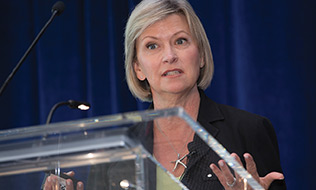
Cancers caused by the human papillomavirus are on the rise but not necessarily among the demographic groups employers might expect, a speaker told delegates at Benefits Canada’s Healthy Outcomes conference in May.
While commonly known as a cause of cervical cancers in women, both sexes are seeing a major rise in anogenital and oral cancers associated with the virus, said Dr. Nancy Durand, an assistant professor of obstetrics and gynecology at the University of Toronto.
“Men, of course, can get external genital warts, but we’re now realizing the importance of these other factors in causing things like oral cancers . . . as well as anal cancers and penile cancers,” she said.
Read: How to use online health platforms to reach decentralized workforces
While HPV vaccination efforts have traditionally focused on younger women, there’s evidence that men should receive the vaccine as well, said Durand. “When men come into contact with HPV, their response is different from women. Fewer of them at all develop any antibody response, which is your protective response to decrease the chance you’re going to get another infection. And the men that do develop antibodies, the levels will be much lower than those with women. And it’s not understood why.”
A study showed an almost 90 per cent reduction in external genital warts for vaccinated men and a drop of more than 75 per cent for anal precancerous cells.
Women over the age of 26 should also be vaccinated, even if they’ve received a vaccine before, suggested Durand. Older women who previously had an HPV vaccine are likely to have received a version covering four strains of the infection at most, while the updated vaccine, released in 2015, covers nine strains.
Read: How health coaching can help diabetes patients
The likelihood of contracting HPV at an older age also remains significant, Durand noted. For women over the age of 30 and currently free of HPV, the five-year risk of contracting it is 20 per cent. For women aged 45 and older, it remains more than 10 per cent.
Durand cited online dating as a factor in the increased risk of HPV. “Where do we meet our partners now? We don’t necessarily go to church or synagogue or bridge to meet our new partner,” she said.
A rising issue is oral cancer, according to Durand. “It’s intimate contact through oral sex. So if you look at the HPV types in the mouth of one partner, they will be HPV types in the genitals of the other partner.”
The inclusion of an HPV vaccine in an employee benefits plan makes sense, said Durand, noting it takes fewer HPV vaccinations to prevent death than is the case with other vaccines, such as those for chicken pox. It takes 700 HPV vaccines to prevent a death from cervical cancer, eight HPV vaccines to avert a case of external genital warts and just 15 to 30 to stop an instance of precancerous cells on the cervix, she said.
Read more coverage from the 2018 Healthy Outcomes conference.
